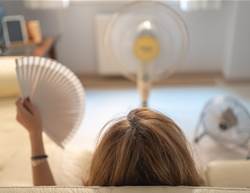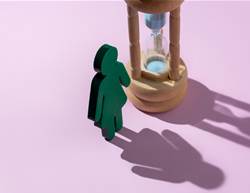Erin Johnson was shopping with a friend this summer when she suddenly became so overheated that she broke out in a sweat, her face turned beet red and she felt compelled to sit down. “I’d had sensations like that before, but this one was so intense, it was disorienting,” says the 48-year-old mother of two. “What was different this time was the sweating—my hairline, the back of my neck, everything became damp in what felt like seconds.”
Neither Johnson’s doctor nor any other physician can say for certain if she was having a hot flush, the most common of the vasomotor symptoms (VMS) associated with menopause, since no clinical test currently exists to confirm them. But given her age and what she experienced, there’s a strong likelihood it was an all-too-common symptom of perimenopause.
“Both hot flushes and night sweats, which are hot flushes that occur while you’re sleeping, can happen during perimenopause and menopause itself, when a woman stops having her period,” says OB/GYN Dr Jessica Chan. “You can experience VMS up to five years before your final period.”
Whether or not you know for sure that what you’re experiencing is menopause-related VMS, it’s important to talk to your doctor to better understand the changes occurring in your body and to explore ways to minimise symptoms before they become worse. Here are some questions to help you start the conversation:
What causes hot flushes?
Both night sweats and daytime hot flushes like the one Johnson experienced are caused by the natural decline of oestrogen in a woman’s body as she approaches menopause. The reaction that causes you to feel hot and suddenly sweaty starts in the hypothalamus—the part of the brain that regulates body temperature.
To keep your internal temperature balanced, the body relies on a delicate relationship between oestrogen and a brain chemical called neurokinin B (NKB). During menopause, the levels between the two become unbalanced, causing neurons in the hypothalamus to misread the body’s actual temperature. In response, the body attempts to cool down by triggering hot flushes and night sweats, often leading to sudden perspiration.
Can hot flashes affect my quality of life?
The short answer is yes—but they don’t necessarily have to. Symptoms can range from mild to severe, with some women barely noticing them at all and others experiencing significant disruption to daily life. Many women feel the effects during sleep, but hot flushes can strike at any time of day, affecting mood, focus, energy levels and overall wellbeing.
“Some women don’t recognise the symptoms for what they are because they can be subtle at first,” says OB/GYN Dr Nanette Santoro. “They come in different wattages.”
Some women suspect their symptoms are linked to VMS but feel they’re too young for menopause or they worry they won’t be taken seriously by friends—or even their GP. “The symptoms can also have an erosive effect,” says Dr Santoro, noting that they can gradually worsen over time. “You might brush them off, thinking, ‘I’m busy, so it’s fine.’ Then suddenly it’s not. Women don’t always notice when they’ve reached the tipping point.”
Hot flushes and night sweats aren’t the only changes to watch for. “Pain during sex and vaginal dryness are also linked to perimenopause,” says Dr Chan. The key is to share all symptoms with your doctor so they can get the full picture and offer the most effective treatment options.
What can I do to minimise VMS?
Doctors often suggest starting with lifestyle changes, depending on how severe the symptoms are. “Daily exercise, a well-balanced diet, yoga and meditation may help, but they can only go so far because the root cause is a drop in oestrogen,” explains Dr Chan.
Other practical strategies that can offer relief include dressing in layers, so you can cool down quickly when needed. “VMS is not just about feeling hot—it’s more about having a narrow temperature comfort zone,” says Dr Santoro. “Some women carry battery-operated fans. Others use cooling mattresses, which can be helpful if the symptoms are worse at night.”
Are there things I’m doing that can make VMS symptoms worse?
Yes. Excess caffeine or alcohol, tobacco use and a high body mass index (BMI) can intensify symptoms, says Dr Chan. “Living in hot, humid climates can also make it harder to regulate body temperature,” she adds.
Do some women experience worse VMS than others?
Yes. Research shows that Black and Latina women tend to experience vasomotor symptoms (VMS) more frequently and for a longer duration than white women. “This is a very active area of research,” says Dr Chan. The exact cause remains unclear, but doctors suspect hormonal differences may play a role. Cultural attitudes may also influence symptom reporting, with some communities less likely to speak up about what they’re going through—potentially delaying diagnosis and treatment.
When should I start treating my VMS?
“As soon as you begin to notice symptoms, that’s the right time to raise it with your doctor,” says Dr Chan. It’s helpful to track your menstrual cycles—especially if they become irregular or noticeably different. These changes, along with symptoms like hot flushes or night sweats, can sometimes resemble other conditions, such as thyroid disorders. “But if your cycle is shifting and you’re close to 50, it’s more than likely related to menopause,” she explains.





.png&h=193&w=250&c=1&s=1)



